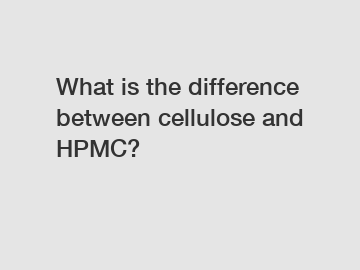What is the difference between cellulose and HPMC?
What is the difference between cellulose and HPMC?
Cellulose and Hydroxypropyl Methylcellulose (HPMC) are two widely used substances in various industries. While both are derived from cellulose, they have distinct properties and applications. If you're curious about the dissimilarities between these two compounds, let's delve into their characteristics, uses, and differences.
1. Definition and Structure:

- Cellulose: It is a naturally occurring polysaccharide found in the cell walls of plants and is the most abundant organic compound on Earth. Its linear chains consist of glucose molecules.
- HPMC: Also derived from cellulose, hydroxypropyl methylcellulose is a chemically modified cellulose ether. It is formed by treating cellulose with propylene oxide and methyl chloride, resulting in a compound with enhanced properties.
2. Physical Properties:
- Cellulose: This organic polymer exists as a white, odorless powder or fibrous material. It is insoluble in water but can absorb and retain vast amounts of it.
- HPMC: It is also a white powder, soluble in water, and can form a clear, viscous solution. The viscosity of HPMC depends on its molecular weight and degree of substitution, allowing for various applications.
3. Applications:
- Cellulose: Due to its abundance and unique properties, cellulose finds extensive use in multiple domains. It is utilized in the production of paper, textiles, films, and as a bulking agent in food and pharmaceutical products. Additionally, cellulose derivatives such as ethyl cellulose and carboxymethyl cellulose (CMC) are employed in various industries.
- HPMC: With its versatile characteristics, HPMC has gained prominence in several industries, including construction, pharmaceuticals, personal care, and food. It is commonly used as a thickener, emulsifier, and stabilizer in cosmetic products, while in the construction sector, HPMC acts as a binder and rheology modifier in cement-based products like mortars and tile adhesives.
4. Functionality:
- Cellulose: The fibrous nature of cellulose provides structural integrity to plants, enabling them to stand upright. In various industries, cellulose's most notable function is its ability to retain moisture and provide bulking properties.
- HPMC: HPMC offers a wide range of functionalities, largely dependent on its viscosity and degree of substitution. It acts as a film-former, enhances adhesion, and controls the release of active substances. In the food industry, HPMC can contribute to the texture and stability of liquid products.
5. Solubility and Compatibility:
- Cellulose: Unlike HPMC, cellulose is insoluble in water. However, it can absorb water and swell, providing unique rheological properties in certain applications.
- HPMC: In contrast, HPMC is water-soluble, allowing for easy incorporation into aqueous systems. Moreover, it exhibits compatibility with many other additives, making it a versatile ingredient in various formulations.
In conclusion, while cellulose and HPMC are derived from the same source, their chemical modifications result in distinct properties and applications. Cellulose is primarily employed as a bulking agent and retains great significance in the paper and textile industries. On the other hand, HPMC offers enhanced functionality, solubility in water, and is widely used in pharmaceuticals, construction, and personal care products. Understanding their differences is crucial for maximizing their utilization in diverse industrial sectors.
The company is the world’s best Construction Additives VAE Powder, VAE copolymer for grouts and tiling, Redispersible polymer powder vs copolymer powder supplier. We are your one-stop shop for all needs. Our staff are highly-specialized and will help you find the product you need.


